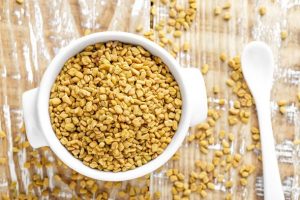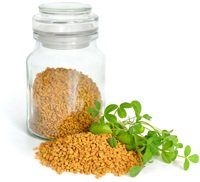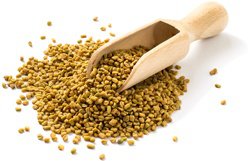Fenugreek is a natural herb that has many benefits for your health and well-being.
It has played a key role in alternative medicine for thousands of years.
These days, it’s often consumed as a supplement.
Fenugreek may have benefits for testosterone levels, blood sugar, breastfeeding and more.
Below is everything you need to know about fenugreek, including its benefits, side effects and how to use it.
WHAT IS FENUGREEK?
Fenugreek is a plant that’s known scientifically as Trigonella foenum-graecum.
The plant stands around 2–3 feet tall (60–90 cm). It has green leaves, small white flowers and pods that contain small golden brown fenugreek seeds.
This is what the seeds look like:
Fenugreek is a plant that’s known scientifically as Trigonella foenum-graecum.
The plant stands around 2–3 feet tall (60–90 cm). It has green leaves, small white flowers and pods that contain small golden brown fenugreek seeds.

For thousands of years, fenugreek has been used in alternative and Chinese medicine to treat skin conditions and many other diseases.
In more recent years, it has become a common household spice and is used as a thickening agent. It can also be found in products such as soap and shampoo.
Fenugreek seeds and powder are also used in many Indian and Asian recipes for their nutritional profile and slightly sweet, nutty taste.
Bottom Line: Fenugreek is an extremely diverse and interesting herb with many uses and potential health benefits.
Nutrition Facts
Although you wouldn’t consume fenugreek in large amounts, one tablespoon of whole seeds contains 35 calories and several nutrients:
Fiber: 3 grams.
Protein: 3 grams.
Carbs: 6 grams.
Fat: 1 gram.
Iron: 20% of your daily requirements.
Manganese: 7% of your daily requirements.
Magnesium: 5% of your daily requirements.
Bottom Line: Fenugreek seeds have a healthy nutritional profile, containing a good amount of fiber and minerals such as iron and magnesium.
Effects on Testosterone Levels in Men
One of the most common reasons men use fenugreek supplements is to boost testosterone.
Some studies have found that it has beneficial effects, including increasing testosterone levels and boosting libido.
In one study, researchers provided 500 mg of fenugreek per day and combined it with an 8-week weight lifting program. 30 college-aged men performed four training sessions per week, with half of them receiving the supplement.
Compared to the non-supplement group who experienced a slight decline in testosterone, researchers found an increase in testosterone in the fenugreek group. This group also had a 2% reduction in body fat.
When assessing changes in sexual function and libido, one 6-week study provided 30 men with 600 mg of fenugreek. The majority of participants reported increased strength and improved sexual function.
Bottom Line: Although more research is needed, initial research suggests that fenugreek can boost testosterone levels and sexual function in men.
Fenugreek Can Help Control Diabetes and Blood Sugar Levels
The most impressive research on fenugreek has analyzed how it affects metabolic conditions such as diabetes.
It seems to benefit both type 1 and type 2 diabetics, along with improving general carb tolerance in non-diabetic, healthy individuals.
In one study in type 1 diabetics, researchers added 50 grams of fenugreek seed powder to the participants’ lunches and dinners for 10 days.
A 54% improvement was found in 24-hour urinary blood sugar clearance, along with reductions in total and LDL cholesterol.
Additionally, a meta-analysis examined the results of nine different studies that tested four herbs, including milk thistle, cinnamon and fenugreek.
Interestingly, fenugreek reduced fasting blood sugar levels by an average of 38.05 mg/dl, which was much more than all the other herbs.
Finally, one study gave non-diabetic participants fenugreek and witnessed a 13.4% reduction in blood sugar levels four hours after consumption.
These benefits may occur due to fenugreek’s role in improving insulin function. However, the benefits observed in studies using whole fenugreek powder or seeds may be partly due to the high fiber content.
Bottom Line: Fenugreek has relatively strong research supporting its role in blood sugar control and the treatment of type 1 and 2 diabetes.
Other Health Benefits of Fenugreek
Fenugreek has been used to treat a long list of diseases and conditions in alternative medicine.
However, many of these uses have not been studied well enough to reach strong conclusions.
Preliminary research suggests that fenugreek can help with the following:
Appetite control: So far, three fenugreek studies have shown a reduction in fat intake and appetite. One 14-day study found that participants spontaneously reduced total fat intake by 17%.
Cholesterol levels: There is some evidence that it can lower cholesterol and triglyceride levels.
Heartburn: One 2-week pilot study in people with frequent heartburn found that fenugreek reduced their symptoms. Interestingly, its effects matched those of antacid medications.
Inflammation: Fenugreek has been shown to have anti-inflammatory effects in rats and mice. More research is needed to confirm this in humans.
Also, some reviews and anecdotal reports from traditional medicine suggest it can help with ulcerative colitis, other skin conditions and numerous illnesses.
Bottom Line: Although more research is needed, initial data shows that fenugreek may also have several other health benefits.
How to Supplement With Fenugreek
Fenugreek can be consumed in several concentrations and forms, so there is no single recommended dose.
Additionally, the dosage may vary depending on the benefit you seek.
Most testosterone-based research uses only around 500 mg of fenugreek extract, while research in other areas has used around 1,000–2,000 mg.
If using the whole seed, doses of around 2–5 grams seem effective, but it does vary from study to study.
To take fenugreek in supplement form, it may be best to start off at 500 mg and increase to 1,000 mg after 2–3 weeks if you don’t experience any side effects.
It can be taken before or with a meal, but because it helps control blood sugar levels, it would make sense to take it with your highest carb meal of the day.
Bottom Line: How much fenugreek you should take depends on the type of supplement as well as the goal of supplementation. In pill form, the recommended dosage is around 500–1,000 mg per day.
Safety and Side Effects
Several animal studies have tested the safety of fenugreek seeds and supplements.
It appears relatively safe for healthy individuals. Animal studies did not find negative effects until doses reached nearly 50 times the recommend dose.
In humans, the current research hasn’t reported any serious health issues when taken at the recommended dose.
However, as with most supplements, less serious side effects like diarrhea and indigestion have been reported anecdotally.
People may also experience a reduced appetite. This is often a good thing, except if you have an eating disorder or are trying to gain weight.
Moreover, some people report a strange and slightly sweet body odor when supplementing, but this is unconfirmed.
And given that it lowers blood sugar levels, it should be used with caution if you are taking diabetes medication or other supplements that lower blood sugar levels.
It’s always a good idea to check with a medical practitioner before starting a new supplement. Most importantly, ensure that you’re taking a safe dose.
Bottom Line: In humans, some mild side effects may occur, although fenugreek appears relatively safe at the correct dosage.
Summary
Fenugreek is an extremely interesting and versatile herb.
It is claimed to have benefits for various health conditions and has been used for all sorts of purposes in herbal medicine.
However, modern science is just beginning to discover its true benefits.
Based on the available evidence, fenugreek has benefits for lowering blood sugar levels, boosting testosterone and increasing milk production in breastfeeding mothers.
Fenugreek may also benefit cholesterol levels, lower inflammation and help with appetite control, but more research is needed in these areas.
More research on this powerful medicinal plant is underway, and it will be interesting to see the results in the years to come.
Excerpt: Authority Nutrition.





